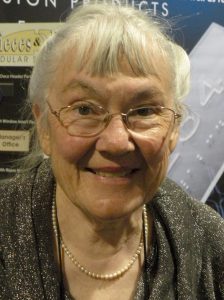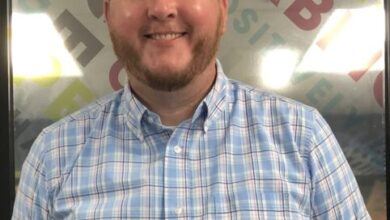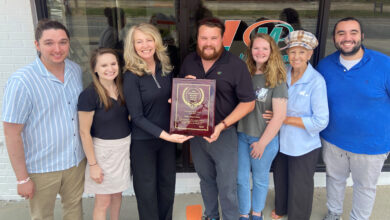
Sharon Toji, widely known as the “ADA Sign Lady,” is an expert in ADA signage and ANSI compliance standards for ADA signage. She is president of ADA Sign Products, and owner of Access Communications, a consultancy special-izing in ADA standards and codes.
You’re known far and wide as The ADA Sign Lady. What path led to you becoming a national authority on ADA signage?
Two of the many things I had done in the past came together after I joined my husband’s sign company. First, I was originally involved with disability issues through a contest I won as a teenager sponsored by President Eisenhower for the “Presidents Committee on Employing the Physically Handicapped.” Then, my first child was born with severe multiple disabilities, including blindness and deafness. Second, as a result of a work study grant at Reed College, I became Reed’s acting U.S. Documents Librarian. I was very familiar with government documents, how to index them and find things in them. So, when I heard about the ADA, and that signs were part of it, I had the interest in disability, especially as it concerned people with sensory disabilities, and I had the tools from my documents background to read and understand the standards. After a lot of research and talking and writing back and forth with the folks at the U.S. Access Board and the California Division of the State Architect, I wrote an article for Sign Business Magazine, which was accepted and published. My phone began to ring, I wrote a manual, I was invited to a sign show, I was invited to represent the sign industry on the ANSI Committee, and the rest is history!
The federal government has made movements toward chipping away parts of the Americans with Disabilities Act. Are you worried it may alter current signage standards?
Yes, I am worried about what the administration will, I’m sure, try to do. Congress is already moving in that direction. However, the standards will probably remain as they are because it takes a lot of trouble and time to change them. But if the entire ADA is diminished, then standards will not matter one way or another! As someone who has now entered the ranks of the disabled, I see on a personal level how important tiny little sections of the standards are – like the amount of bevel on a curb cut. That is magnified by all the tiny details for signs. But until the administration sees people with disabilities, including old people, as a potential powerful voting bloc, they won’t care.
In what areas do you feel current ADA signage requirements fall short of what is needed?
The standards are pretty good for tactile signs that identify rooms. We definitely need a measurable contrast standard – I’ve worked on that for about 15 years, and am thwarted every time, at the last minute, by the designers. We are ignoring the large population of people with defective color vision – starting with eight percent of the male population. We also need better standards for visual sign characters. Most people with vision-based disability have partial vision. Very few people read solely by touch. For instance, directional signs should have larger minimum sizes for characters. We need standards for directories, site and floor plans and evacuation plans that make sense and are workable. Informational signs sometimes need small characters – even less than 5/8 inch, but directional signs need to be much larger than 5/8 inch. It sounds simple to use “one size fits all” standards, but it doesn’t really provide access, or even good signage.
When you were working to help enact ADA sign regulations, did you ever imagine the large industry that would arise for the creation of these kinds of signs?
I’m not sure I envisioned how huge it would become, but i knew it had that potential, because technically, every single public building in the United States would need new signs. I tried to tell the sign industry that, back in 1992. They were actually opposed to the ADA. They laughed at me, and told me that the whole thing would blow over in a couple of years. I told them I couldn’t believe that the sign industry would reject a law that required businesses and government buildings to order new signs! We still find way too many sign companies who know nothing about the ADA, and especially way too many who sell the signs to make money, but don’t bother with the rules. I think there is definitely a large market out there for companies who advertise that they know the standards, know how to design really attractive signs that meet the standards, and then prove that by displaying attractive and legal signs on their websites and at trade shows.
What process do you use to create your signs, and how does it differ from when you started in the industry?
We did not make our own signs in the beginning, because I didn’t want to start production with the wrong method. We never believed in photopolymer. Initially, we started with raster braille and applied characters, developing our own methods for making sure the characters would stay on. We also did a lot of inlaid characters in response to a request for a vandal proof specification for the Los Angeles Unified School District. Now, however, our favorite in-house method is thermoforming, and we think that is the way to go. We wish more companies would look into it. It’s great for traditional ADA signs, and also for the “new” signs where you can have two parts – one visual and one tactile. Those are the very best ADA signs because they provide the best type of sign for both “touch readers” and visual readers, and I thank Roger Whitehouse, now retired founder of Whitehouse Design, for coming up with this innovative idea. I wish more designers would use the technique, and more architects understood it and requested it.
The sign industry has evolved greatly since you joined H. Toji and Company. What has been the most drastic change you’ve had to endure?
I wouldn’t call it endurance. I would call the changes exciting. When I joined the company, it was a completely old-fashioned commercial sign company. I convinced my husband, Tosh Toji, to buy one of the first die cut machines to come out, and then to purchase one of the first Gerber machines. I taught myself the computer, bought one of the first Macs, learned Illustrator, and taught several young sign designers to use the computer. We are still a Mac-based company.
If you hadn’t gotten involved in the signage industry, what career do you think you would be involved with instead?
I’d be doing something in the non-profit sector, maybe as an arts administrator or teaching in some way. I might even be in politics as an activist for good government – probably tilting at windmills or trying to save the world. I can’t imagine that I’d be retired.




